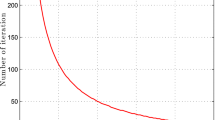Abstract
In this paper, we propose two improved fixed point iterative methods for tensor complementarity problem (TCP), which decrease the number of fixed point iterations. First, based on the tensor splitting, we develop two-step fixed point iterative method and prove that this method converges to a solution of TCP. Then, we present subspace fixed point iterative method for TCP with \(\mathcal { L}\)-tensor and this method still holds the monotone convergence property. Numerical experiments illustrate the effectiveness of our proposed methods.


Similar content being viewed by others
Data availability
We do not analyze or generate any datasets, because our work proceeds within a theoretical and mathematical approach.
References
Ahn, B.: Solution of nonsymmetric linear complementarity problems by iterative methods. J. Optim. Theory Appl. 33, 175–185 (1981)
Che, M., Qi, L., Wei, Y.: Positive-definite tensors to nonlinear complementarity problems. J. Optim. Theory Appl. 168, 475–487 (2016)
Dai, P.: A fixed point iterative method for tensor complementarity problems. J. Sci. Comput. 84, 49 (2020)
Dai, P., Wu, S.: The GUS-property and modulus-based methods for tensor complementarity problems. J. Optim. Theory Appl. 195, 976–1006 (2022)
Ding, W., Luo, Z., Qi, L.: P-tensors, P$_0$-tensors, and tensor complementarity problem. Linear Algebra Appl. 555, 336–354 (2018)
Ding, W., Wei, Y.: Solving multi-linear systems with \(\cal{M} \)-tensors. J. Sci. Comput. 68, 689–715 (2016)
Du, S., Zhang, L.: A mixed integer programming approach to the tensor complementarity problem. J. Glob. Optim. 73, 789–800 (2019)
Guan, H., Li, D.: Linearized methods for tensor complementarity problems. J. Optim. Theory Appl. 184(3), 972–987 (2020)
Han, L.: A continuation method for tensor complementarity problems. J. Optim. Theory Appl. 180(3), 949–963 (2019)
Huang, Z., Qi, L.: Formulating an n-person noncoorperative game as a tensor complementarity problem. Comput. Optim. Appl. 66, 557–576 (2017)
Huang, Z., Qi, L.: Tensor complementarity problems-part I: basic theory. J. Optim. Theory Appl. 183(1), 1–23 (2019)
Qi, L., Huang, Z.: Tensor complementarity problems-part II: solution methods. J. Optim. Theory Appl. 183(2), 365–385 (2019)
Huang, Z., Qi, L.: Tensor complementarity problems-part III: applications. J. Optim. Theory Appl. 183(3), 771–791 (2019)
Li, G., Li, J.: QN-tensor and tensor complementarity problem. Optim. Lett. 16, 2729–2751 (2022)
Liu, D., Li, W., Vong, S.W.: Tensor complementarity problems: the GUS-property and an algorithm. Linear Multilinear Algebra 66(9), 1726–1749 (2018)
Luo, Z., Qi, L., Xiu, N.: The sparsest solutions to \(Z\)-tensor complementarity problems. Optim. Lett. 11(3), 471–482 (2017)
Pearson, K.: Essentially positive tensors. Int. J. Algebra 4, 421–427 (2010)
Shao, J., You, L.: On some properties of three different types of triangular blocked tensors. Linear Algebra Appl. 511, 110–140 (2016)
Song, Y., Qi, L.: Tensor complementarity problem and semi-positive tensors. J. Optim. Theory Appl. 169(3), 1069–1078 (2016)
Song, Y., Qi, L.: Properties of tensor complementarity problem and some classes of structured tensors. Ann. Appl. Math. 33(3), 308–323 (2017)
Song, Y., Qi, L.: Strictly semi-positive tensors and the boundedness of tensor complementarity problems. Optim. Lett. 11(7), 1407–1426 (2017)
Song, Y., Yu, G.: Properties of solution set of tensor complementarity problem. J. Optim. Theory Appl. 170(1), 85–96 (2016)
Xie, Y., Ke, Y.: Neural network approaches based on new NCP-functions for solving tensor complementarity problem. J. Appl. Math. Comput. 67, 833–853 (2021)
Xu, Y., Gu, W., Huang, Z.: Estimations on upper and lower bounds of solutions to a class of tensor complementarity problems. Front. Math. China. 14(3), 661–671 (2019)
Wang, X., Che, M., Qi, L., Wei, Y.: Modified gradient dynamic approach to the tensor complementarity problem. Optim. Methods Softw. 35, 394–415 (2020)
Wang, X., Che, M., Wei, Y.: Global uniqueness and solvability of tensor complementarity problems for \(H^+\) -tensors. Numer. Algorithms 84(2), 567–590 (2020)
Wang, X., Che, M., Wei, Y.: Randomized Kaczmarz methods for tensor complementarity problems. Comput. Optim. Appl. 82(3), 595–615 (2022)
Wei, P., Wang, X., Wei, Y.: Neural network models for time-varying tensor complementarity problems. Neurocomputing 523, 18–32 (2023)
Zhang, K., Chen, H., Zhao, P.F.: A potential reduction method for tensor complementarity problems. J. Ind. Manag. Optim. 15(2), 429–443 (2019)
Acknowledgements
The work was supported by National Natural Science Foundation of China (12171384).
Author information
Authors and Affiliations
Corresponding author
Ethics declarations
Conflict of interest
The authors have no relevant financial or non-financial interests to disclose.
Additional information
Communicated by Liqun Qi.
Publisher's Note
Springer Nature remains neutral with regard to jurisdictional claims in published maps and institutional affiliations.
Rights and permissions
Springer Nature or its licensor (e.g. a society or other partner) holds exclusive rights to this article under a publishing agreement with the author(s) or other rightsholder(s); author self-archiving of the accepted manuscript version of this article is solely governed by the terms of such publishing agreement and applicable law.
About this article
Cite this article
Li, G., Li, J. Improved Fixed Point Iterative Methods for Tensor Complementarity Problem. J Optim Theory Appl 199, 787–804 (2023). https://doi.org/10.1007/s10957-023-02304-2
Received:
Accepted:
Published:
Issue Date:
DOI: https://doi.org/10.1007/s10957-023-02304-2




